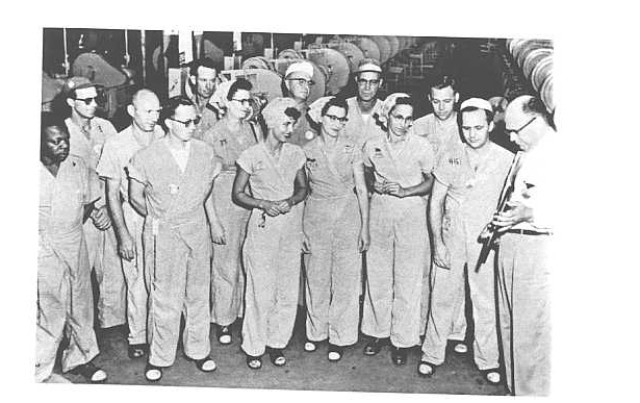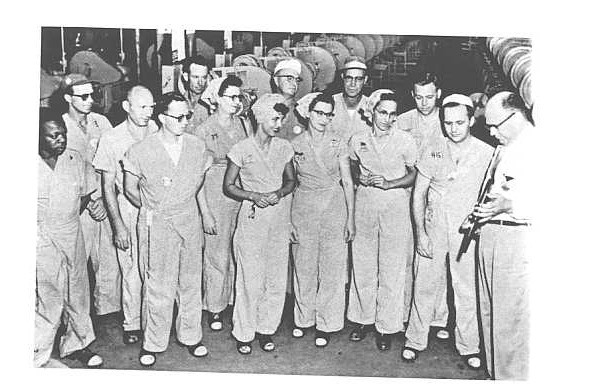Aca,!A"What a diffAca,!a,,crence a day makes, twenty-four little hoursAca,!A|Aca,!A?
What a difference June 25, 1941, made; a day that created the landscape for federal employment equality. That date may not bear notable significance to the general public; but for African- Americans during that era, June 25 marked the beginning of desegregated government and defense employment.
On June 25, 1941, President Franklin D. Roosevelt issued Executive Order 8802.
This order encouraged Aca,!A"full participation in the national defense program by all citizens of the United States, regardless of race, creed, color, or national origin, in the firm belief that the democratic way of life within the Nation can be defended successfully only with the help and support of all groups within its borders.Aca,!A?
In twenty-four hours, African-Americans gained a privilege and a chance to contribute to an American effort. World War II introduced a great need for workers to support the war and with that executive order, African-Americans joined the effort as well. In order for them to fill those jobs, there had to be a measure in place allowing African-Americans to legally do the job without being denied.
According to the Twin Cities Ordnance Plant Historic Plant Investigation, (Vogel & Crown)Aca,!A? The supply of available factory workers was consequently declining just at the time that industry was expanding. The labor supply shortfall was partly filled by women, African-Americans, the elderly, and other formerly excluded groups. The TCOP or Twin Cities Ordanance Plant (in Arden Hills, Minn.) and other war industries created unprecedented opportunities for women, African-Americans, Hispanics and other minorities to earn a livelihood.Aca,!A?
Even though Executive Order 8802 removed pre-existing barriers, the creation of the order wasnAca,!a,,ct as simple as an overnight decision. Predating Executive Order 8802 was A. Philip Randolph. Head of the Brotherhood of Railway Car Workers, Randolph advocated the inclusion of African-Americans as government employees.
It is believed that Roosevelt issued Executive Order 8802 as a result of RandolphAca,!a,,cs threat to march on Washington, D.C.-- many years before Dr. Martin Luther King Jr. did so successfully.
Joint Munitions Command historian Keri Pleasant added a broader view to the impact of Executive Order 8802.
Aca,!A"In World War II the Ordnance Department owned over 112 ammunition installations and the contractors operating the plants hired between 10-20,000 workers at each plant during wartime periods -- we needed the whole country to come together to fill these positions,Aca,!A? Pleasant said.
In addition, Pleasant said Rock Island Arsenal in Illinois employed African-Americans during World War I in the manufacturing sector but there were also African-Americans employed at the ammunition plants -- she just needed to locate the supporting documents.
She said, Aca,!A"The first decision was to search at the installation level (for supporting documents). ItAca,!a,,cs often an EEO break out of employees that reveals the number of African-Americans.Aca,!A? Pleasant added,Aca,!A? But then comes the task of finding historical files to further support their inclusion.Aca,!A?
As a historian, Pleasant seeks to locate historical documents that tend to tell the story from the plants, often during command assessments. Aca,!A"We ask that historical reports are accompanied by supporting documents -- we try to encourage people (historical officers) to give us that back up.Aca,!A?
Most importantly she said, Aca,!A"Yes, we are out there asking -- we probably could ask more.Aca,!A? But Pleasant noted that Aca,!A"weAca,!a,,cre trying to save more electronically.Aca,!A?
The value of documentation of everyday and historical events is important to JMC. Questions concerning the command in earlier days as well as the environment of the plants comes with a command as complex as JMC. Aca,!A"ItAca,!a,,cs always good to find answers,Aca,!A? said Pleasant. Aca,!A"These questions come up and will come up in the future.Aca,!A?
While some of the defense plants directly affected by Executive Order 8802 are long gone, others remain open and operational. Determining how the ammunition lines looked some 68 years ago is no easy task, as command historian Pleasant explained. Joint Munitions Command historical data notes an increase in the hiring of African-American employees in such plants and there is the executive order that required it.
However, there is one ammunition plant that has unique, tangible evidence supporting a history that began with Executive Order 8802.
JMCAca,!a,,cs McAlester Army Ammunition Plant, formerly McAlester Naval Depot, houses an open account of what the plant was like following the executive order. The account gives a feel for the environment of the depot and efforts to keep the mission going despite obvious changes.
Ultimately, you cannot change history nor the circumstances that shaped it; but you can acknowledge and celebrate the journey thus far.




Social Sharing